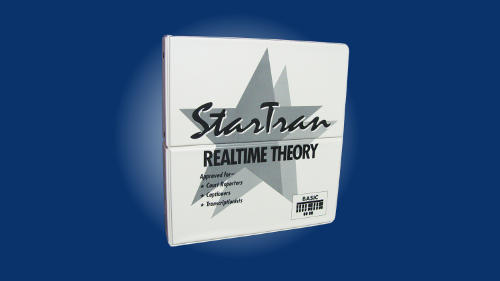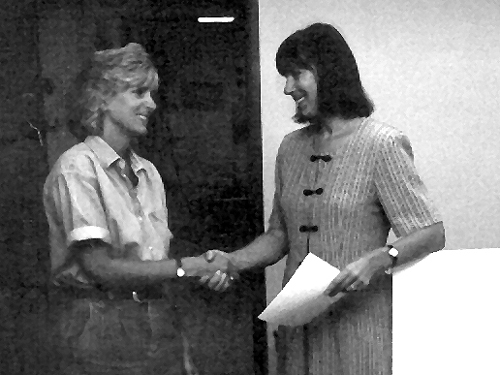StarTran Realtime Theory
Would you like to become a court reporter?
A captioner? Be a CART provider?
It all starts with your court reporting theory.
Steno theory, also known as court reporting theory, is the language of court reporting. It is the first and by far the most important course in any court reporting training program. It is in theory class you learn how to write machine shorthand.
In today’s court reporting and captioning world, computers with translation software instantaneously read machine shorthand and display the translation for all to see, so it is vital that reporters learn a “realtime” court reporting theory. StarTran was approved as a realtime theory by the National Court Reporters Association in the early 2000’s, and though NCRA no longer approves theories, StarTran Realtime Theory has only been updated, streamlined, and improved with the times.
From StenoLife, Tiffany De Bruin shares what court reporting is all about!
Since theory is the foundation upon which your entire court reporting education and realtime career will be built, it is important to get the best court reporting theory you can in order to avoid the pitfalls and plateaus in speedbuilding that many students experience due to weak theories. In fact, you could attend the most well-known court reporting program with the most advanced technology, but if it doesn’t teach a great realtime theory, you’re not getting the best court reporting education and you will still struggle to reach a high translation rate well after you graduate and become certified.
Learning StarTran Realtime Theory in the unique StarTran Online court reporter training program PRIOR to attending a non-StarTran court reporting school or an online court reporting program for speedbuilding is the best way to ensure that you have the most solid foundation and state-of-the-art realtime court reporting theory possible. StarTran Realtime Theory was created to give students a truly conflict-free high-translating realtime theory, one that is logical and consistent, and therefore easier to learn, one that is condensed with many short forms to make it faster to write, and one that has plenty of practice material to really ingrain the concepts. With StarTran, you are guaranteed to be better prepared with a more relevant, more comprehensive, and more realtime theory than anyone else in the class!
StarTran Realtime Theory is the Best Way to Start your Court Reporting Training!
I’m very glad I ordered StarTran. All of the materials are so well thought out, structured, and presented. The combination of the theory, reference, and instructor’s manuals and your taped drills and instructions help me to feel confident that I’m learning the theory thoroughly and well and am reinforcing what I’m learning as I go along.
For the student who’s learning theory on their own, this seems about as close as you can get to being in a classroom with an experienced and skilled teacher. I really appreciate all of the thought, work, care, and skill you put into the StarTran materials. As I mentioned, I ordered a home-study court reporting course, and in terms of quality, your materials are just head and shoulders above that course. I’ve also ordered other theory and practice materials from various sources, and yours are just first-rate. I’m glad I found them.
Looking at the way that the different theories were taught, I was happy with the way that StarTran gave me what I needed to know up front. For example, when you learn theory, even from the first lesson in StarTran, you learn briefs and phrases of words, which other theories don’t teach you at all. They teach you to write everything out and learn briefs and phrases after you have finished theory.
In my experience, I found that I went through the speeds at a much faster rate because I wasn’t having to look up specific briefs and phrases; most of them I had memorized already and came automatic to me. Also, the content of the material that you study is more relevant. StarTran teaches relevant vocabulary. And the book is kind of fun. At the beginning of each lesson, there’s a little note of encouragement, which is very reassuring.
What Students Say About StarTran Theory
Below is a written interview with four former Harbor College StarTran students. What comes through most clearly is the students’ recognition of their own responsibility to learn and their acknowledgment of the efficacy of the StarTran system. Natalie, Carla, Robin and Ali all are now certified court reporters.
NATALIE, CARLA, ROBIN and ALI all are now certified court reporters. Robin Delloro is an agency owner in Virginia, and Ali Dionisio is a CART captioner in California.
Prepared to Build Speed
STARTRAN: Did StarTran prepare you to go into speed class, write 2-voice, identify speakers, et cetera?
NATALIE: I was very prepared to move on to the next step after completing theory. I wasn’t blown away by what I was hearing in my speed classes. Passing the 60s and the 80s came pretty easy. If I remember correctly, I passed my three 60 tests and three 80 tests within two weeks.
ROBIN: Very, very prepared. I was able to pass the 60 tests the first week. I think I even passed an 80 that same week.
CARLA: I believe I was prepared for speed classes, yeah. I went into the 60 and 80 classes right after theory. I passed some 60 tests pretty much right away. I felt like the speedbuilding on the audios during the theory helped a lot. I knew how to write everything. It was just getting used to doing it at a faster pace.
ALI: It was a gratifying feeling in my first dictation class knowing that all of that hard work done for theory had programmed into my head all that was necessary for me to accurately write all that was being said. And yes, I can do 2-voice and identify speakers — although I was smoked by the dictation the first few times.
The Seven Steps to Success
STARTRAN: Did you follow the Seven Steps? Did they work for you?
NATALIE: I did. These steps involved repetition, which helped me a great deal in implanting the theory in my mind. I would have to say faithfully sticking to and following these Seven Steps helped me the most in learning the theory.
ROBIN: Yes, I followed the Seven Steps, and, yes, they worked for me. I would recommend anyone follow these steps exactly as they are and not cut out any of them. It’s the variety of repetition that makes it all stick.
CARLA: The Seven Steps totally helped. I thought it was great. By writing it out, it just imprinted more on my brain so that I learned it a lot faster. By the time I got to the book to practice it out I already had a lot of it in my head; it was just putting it through to my fingers. And then I only had to go through it maybe a couple times and was able to go to the audio and only had to go through the audio usually once and then take the test.
Briefs & Phrases
STARTRAN: Please comment on learning briefs and phrases in StarTran.
NATALIE: I love my briefs and phrases. They are my life line when it comes to writing. There was enough repetition throughout the theory program to make most of them stick, and the ones that didn’t come naturally, which there were very few of, I tended to drop over time.
ROBIN: I found a majority of the briefs and phrases easy to learn and remember because they are made up of word parts instead of just assigned letters. I’ve talked to students who have other theories, and they think they would prefer their theory to be more like this.
CARLA: I liked the briefs and phrases, most of them. I didn’t find them that difficult to learn. If I felt it was sticking, then I would use it. If I felt it just wasn’t, I just didn’t feel I could recall it that quickly, there was another way I could choose.
ALI: There is definitely a rhyme and reason behind the way the briefs and phrases are concocted. It got to the point where briefs and nonbrief words, despite not readily recalling how they were presented in the text, I was able to figure out by myself because a specific pattern of processing words had been ingrained into my head.
Conflict Control
STARTRAN: Did you like that conflicts were resolved a few in each lesson, and did you know them by the time you finished theory?
NATALIE: The conflicts were the hardest for me to learn, so I was very thankful that they were taught a few at a time and that a definition was given on the tapes to explain the differences between the actual ordinary words. That helped me to associate the stroke with the definition.
CARLA: No, the conflicts were not really that difficult. I liked learning a few at a time, because there are so many words that are alike, but being able to grasp them and try to get them more down rather than having them all at once is better. The audios helped because they put it more into a context so that you can hear the conflict with a sentence and apply it more in your mind rather than just saying, “This is it.”
ALI: The key is to just keep in mind the few subtle exceptions to the patterns that are sometimes taken to avoid conflicts.
Multistroke Writing, Flexibility
STARTRAN: Did you work with multistroke words enough that you can write out phonetically? Were outline choices beneficial?
NATALIE: As far as the vocabulary goes, I was very pleased. I was very happy that there were outline choices rather than only one way to write something. The choices helped me to learn how to telescope when I was writing, and without the choices I probably would have stroked out every little sound I heard.
CARLA: I’d rather not have just one way to do it because what you or someone else might see as easy isn’t necessarily the way that I would have picked. I know just talking with other people I found that a lot of the outlines you choose the same, but there were a few that you want to pick something that you’re going to be able to stick to that you’re comfortable with, you can totally see, yeah, that’s what it is.
ROBIN: Yes, I learned to write out phonetically. Many of the vocabulary words popped up in later vocab classes. Getting used to stroking out words helps to wipe out the hesitation. Different strokes for different folks. I think offering choices recognizes the fact that students will naturally hear some words differently than others may. Giving choices helps a student to stroke a word the way that comes most naturally, which makes it easier to remember.
ALI: As far as StarTran giving us a few options instead of just one set way of writing some words, that’s absolutely a plus — in every which way. It gives you an alternative for briefs that are hard to stroke and it also cultivates using creativity in terms of the way you process words.
Lesson Audios
STARTRAN: Can you comment on StarTran Lesson Audios?
NATALIE: The audios were great. The speed on the audios was a comfortable learning speed, not too slow, yet not too much of a push either. The quality of the drills was great. They really helped me in not hesitating when I was writing.
CARLA: I liked the familiar drilling and the extra material too because they’re trying to get you used to it at different speeds or whatever, because the more you write it the more you know it; it almost becomes automatic. And it’s good to go further too because you’re going to have so many things thrown at you, it’s good to know it nonrehearsed too.
Speed Challenge Section
STARTRAN: Did you try the optional Speed Challenge sections at the end of the tapes?
NATALIE: When I did listen to it and could write those speeds that I thought were just super, super fast, it really boosted my confidence.
ROBIN: I worked the speed-building section of the theory audios after every lesson and sometimes went back a lesson to try it again when it wasn’t quite so fresh to check on my retention.
CARLA: I didn’t use the Speed Challenge section all the way through. Off and on towards the beginning and then towards the end I really did because I knew that I was going to be getting out and having to go into a higher speed and I wanted to be writing that speed.
Reference Volume
STARTRAN: How do you feel about the StarTran Reference Volume?
NATALIE: The Reference Volume, this is the best thing. I can actually say that one more time. There isn’t anything better than this. Not only did I use it in theory, but it’s the handiest, the easiest, the quickest reference book that I have in my library today. I love it. Anything that I forgot, two seconds later I have the forgotten word back in my memory. It’s as easy as that.
ROBIN: I still use it daily. It’s very well organized.
CARLA: I still use it. It’s easy to look things up. I even sometimes use it to practice from. Like I’ll do all the A’s. . .
Teacher’s Manual
STARTRAN: Did you like the in-class dictation from the Teacher’s Manual?
NATALIE: In-class dictation was a way for me to see how much I was learning and what came natural to me and what my problem spots were too that needed to be worked on. Dictation is what court reporting is all about.
ROBIN: It was good to have dictation that focused on the particular section we were working on. Monica [theory instructor] loved that she didn’t have to adjust the material.
Writing Punctuation
STARTRAN: Did you learn to incorporate punctuation into your writing?
ROBIN: Yes. I try to get quote marks in when I am in the trail class. I usually get most of the other common punctuation in during the higher speed classes.
CARLA: I let a little of it go when I’m pushing for speed, but it was emphasized that you need to get punctuation in; otherwise you can change the whole context of the sentence. I learned all the punctuation in theory and there was plenty of practice. I do get it in at a comfortable speed — dashes always, no matter what.
Satisfaction, Confidence
STARTRAN: Are you satisfied with StarTran Theory?
NATALIE: The Practice Habits before each lesson were very beneficial and encouraging, boosted my confidence. I don’t think that I could be any more satisfied or any happier than what I am with this theory. I learned to write realtime in less than six months, and this is something that I’m satisfied with. And I know that it’s going to make me successful in my future.
ROBIN: Definitely, yes. I haven’t heard of anything that other theories do better.
CARLA: I really liked the way the theory was laid out and that we did it self-paced. It took two to three days for a lesson. I feel confident now.
ALI: I love StarTran a ton.




